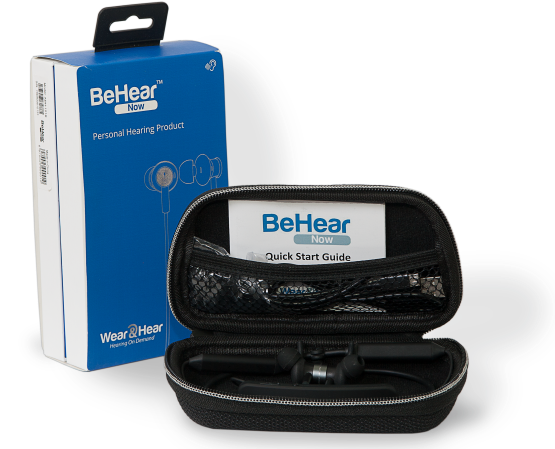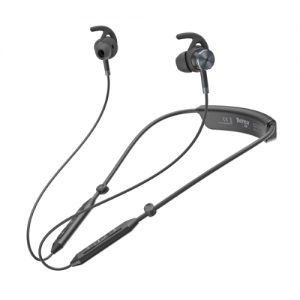BeHear NOW User-Oriented Review by HLAA Member
User Assessment of BeHear NOW Personalizable Hearing Amplifier
♦ The following is a review submitted by Katie Robertson, active in the HLAA (Hearing Loss Association of America) Kentucky chapters
I have tested out the BeHear Now Personal Hearing Product Wear&Hear for a week or so and have found it both advantageous and frustrating for me, a 70-year-old female who has been hard of hearing with increasing increments since the year 1999. My hearing loss is hereditary, as well as due to life’s noises throughout my lifetime (head knocks, loud concerts, etc).
I have thoroughly enjoyed how clearly this product has given me the ability to hear during the “indoor” mode, while conversing in a calm quiet atmosphere. This product produced clearer quality hearing, more so than my RIC hearing aids have done at any time. During a trial of wearing the Wear & Hear apparatus in a noisy restaurant, I put it on the “crowd” mode and found it actually did dampen the background noise enough for me to hear the person talking to me, and enabled me to ignore all the different noises around (clattering silverware, loud children right next to our table, music piped in, and other conversations). I also tried the “music” mode in the car as I listened to a cd and enjoyed hearing the music because the earphones allowed me to hear some of the different parts of the music I often miss with my hearing aids.
What I didn’t like were the rubber “wires” that were easily yanked from the clips that kept them up near my ears. I found them more frustrating than helpful. Additionally, they got caught in my small dangling earrings I wore, and being a jewelry lover, that hampered my normal lifestyle. I know this is a small thing and could be gotten used to, but it is a feature that, if eliminated by a different product, might sway my purchase of one over the other.
One other thing that I also didn’t know how to handle was this: I am by heredity a person who profoundly perspires, and it happens not only when I labor, but during emotion, when flustered and in too much heat. The Wear&Hear reacted to the perspiration since it sits on the neck, and the earphones crackled some, then it turned off. I’m not sure if I could wear it for long at the times I have a lot of perspiration.
In conclusion of my evaluation of the Wear & Hear, I would probably love to be on the lookout for one of the newer models to see what has been changed in the way of improvement. It would definitely be something that I might use alternatively rather than replacing my hearing aids though. Some things about it I liked more than my hearing aids, I definitely liked it more than my PockeTalker, yet I still like my hearing aids on a day in/day out basis since they enable me to wear the jewelry I like to wear.
Thank you for the wonderful opportunity to try this product. I think it was worth it both for my experience, and for your enlightenment by the experiences from a user.
The bottom line:
“This product produced clearer quality hearing, more so than my RIC hearing aids have done at any time.”
BeHear NOW Technical Review by HLAA Member
Technical Assessment of BeHear NOW Personal Hearing Product
♦ The following is a review submitted by Dave Robertson, active in the HLAA (Hearing Loss Association of America) Kentucky chapters
Packaging

Neat and well-organized, with good quality protective case. The Quick Install Guide was clear.
The Smartphone App
Software is attractive and very intuitive. It works with no bugs! Bluetooth connection was easy to make.
The Headset
The design is awkward. The control buttons are awkward to use while wearing. The solution to use cable clips to take up excess cable is very basic and not entirely satisfactory. For example, suspended ear-rings get easily trapped between the cable and the headset frame.
The Technology Used
This is definitely no ‘ordinary’ headset device. The ability for the user to make his/her own audiogram profile using the smartphone app gives the user the control that is much needed by hearing device users. Also the ability for the user to be able to program separate listening profiles to suit their needs. The surprising outcome of the assessment was to find that everything relating to what was left to the user to program (audiogram and profiles) actually worked well and to a higher quality than for the expensive RIC hearing aids the user was used to wearing. This demonstrated that good quality technology had been utilized in the design and manufacture, along with a lot of thought and research into the needs of the user. As mentioned earlier, the weakest part is the physical design of the headset.
Conclusion
The fact that the headset is similar in style to those used by portable music player listeners, the user does not feel the same stigma as many people who wear hearing aids do. Also, to experience a better control of setting up the device to suit a user’s specific requirements and to also to experience a higher quality of hearing, make this device very attractive to use over standard RIC hearing aids, especially when the price point is so low comparatively.
For the user to not have to worry about battery changes and for the manufacturer to be able to take advantage of the larger physical size of the equipment to provide good battery storage and more powerful electronic components to improve hearing quality, makes this device ‘stand out in the crowd’ compared to similar devices on the market.
Apart from having a rethink about cable management and control button ergonomics, I think as a future initiative it would be useful to have an automated facility where the device can identify the environment it is being used in and be able to auto switch onto the respective profile without user intervention. This could be an option given to the user in the smart app to choose manual or auto for the selection of profiles. The parameter to decide on switch over could be set by the user using a sliding button with the app. I would also like to see T-coil implemented.
The bottom line:
“The surprising outcome of the assessment was to find that everything relating to what was left to the user to program (audiogram and profiles) actually worked well and to a higher quality than for the expensive RIC hearing aids the user was used to wearing.”

